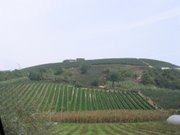[This is a guest posting by Matt.]
First, thanks Marta for granting me this indulgence to hold forth on an obsession.
Anyone who has had any Japanese food has tasted the flavor imparted by katsuobushi, but I first became aware of the ingredient itself through its description in Harold McGee's On Food and Cooking: "The most remarkable preserved fish is katsuobushi, a cornerstone of Japanese cooking, which dates from around 1700 and is made most often from one fish, the skip jack tuna [bonito]." Katsuobushi is produced through a three to five month process involving boiling, weeks of hot-smoking, and finally a series of fermentations. "At the end, the meat has turned light brown and dense; when struck it's said to sound like a resonant piece of wood," McGee continues. "Why go to all this trouble? Because it accumulates a spectrum of flavor molecules whose breadth is approached only in the finest cured meats and cheeses."
Since I read this years ago I've kept my eye out for whole katsuobushi. Of course, in powdered form, it is a basic ingredient in Hon-Dashi, used to make instant soup stock, or dashi. It's also not hard to find in flakes; these are the shavings of katsuobushi that are an intermediate in making dashi.
Indian food tastes better when the spices are ground fresh, because the aromas dissipate rapidly after grinding. Same goes for coffee. Might the same be true of katsuobushi? What if the pre-flaked katsuobushi has but a shadow of its full flavor? I wanted to find the whole stuff.
Once I set to the task in earnest, it was surprisingly difficult. Locally, the best bet was Berkeley's Tokyo Fish Market. Plenty of instant dashi and bonito flakes, but a clerk there told me that whole katsuobushi is almost impossible to find in the United States. Without much hope of success, I also inquired at Japan Woodworker. They sell a lot of Japanese planes, and the Japanese use a special plane to making the katsuobushi shavings. Their kitchen section has expanded a lot in recent years, so I thought this would be a nice area of intersection between woodworking and cooking. (Indeed, I planned to dust off my underutilized planes when it came time to make my own shavings.) Unfortunately, they didn't carry katsuobushi or the plane for it. However, I did have an interesting talk with one of the owners, who had inherited a kastuobushi plane from his father, together with a now 60-year-old piece of katsuobushi.
To the internets! As expected, the web has a lot of good information about katsuobushi. I recommend wikipedia and this article from the Tokyo Foundation. The latter Japanese slow food site has a number of other interesting articles as well. However, when it came to finding whole katsuobushi for sale, the English-speaking internet had nothing. We did find instructions in Japanese about how to make katsuobushi. According to google translate, one step is this:
これで裸節のできあがりです。 I finished the section in the nude.
We like our food to be natural, but maybe not that natural.
Googling did yield a promising site written entirely in Japanese, e-dashi. After weeks of waiting, hoping I guess that katsuo would fall from the sky, we decided to make an order in a language we couldn't understand. The strategy was simple: use google translate and try to divine the original meaning. Do we really want to order "sections of this blight," we asked ourselves? Yes! Confirm buttons were a bit tricky. For that you have to paste the html source (Control-U) into google translate and look for the form fields.
Once the order process was completed, we realized that we had never typed in a credit card number. That happened only after several emails. The first was an auto-reply. The second said the shipping charges were being calculated. The third gave a shipping amount and, according to google translate, required me to confirm. At this point, I gave my sheepish reply, saying I didn't know Japanese, and then writing it in English. Fortunately the person on the other end, Hiromi Nagase, was extremely nice and forgiving, and went to the trouble of writing a reply in English. Hiromi was not at all confident in her English writing, but as someone who has had to edit papers from mechanical engineers, I've seen much worse. In fact, I shouldn't be using "worse", because everything was perfectly clear. Domo arigato gozaimasu, Hiromi-san!
The package came within a week. There may have been a slower, cheaper shipping option, but we're about to go to Japan, so it had to come fast. Why not wait and get it in Japan? Because evidently it's hard to find even there: Our Japanese friend Keisuke had never seen katsuobushi in the flesh.
Anyway, here it is. As you unwrap it, you are hit by a burst of smoky aroma. If you knock on it, it really does sound like a piece of wood.
Here is my British hand plane confusedly making shavings from it. If you are able to get katsuobushi, but don't have or want to invest in a hand plane, you could use a Microplane cheese grater. After all, Microplanes were sold first to woodworkers before chefs discovered they make grate greaters. The shavings would be much finer than those shown here, but they'd probably make good soup. Treat them like a fine grind of coffee, and don't let them steep quite as long.
Honestly I don't understand why this step is enough to stop people from making dashi from whole katsuobushi. It doesn't take long at all, and what's left over is easier to manage in this compact form.
Now for suppo: First step is to add kombu, which is dried kelp. Bring to a boil, then remove the kelp.
Then add the katsuobushi shavings
Return to a boil, and let it steep for a bit. This is vague here, because, despite dire warnings about oversteeping of the form "even master chefs worry that they may be boiling it too long" (instead of worrying, why don't they measure time and temperature, these master chefs?), it doesn't seem that sensitive to the specifics. Anyway, this seems like one of those things said only to deter people from doing things themselves.
Strain. Add miso, or if you want to try the broth plain, salt and msg. Serve:
Ah yes, I almost forgot. How does it taste? There's a short answer and a long answer. The short answer is, Very good!
The long answer: How often we forget to taste familiar foods. The ritual of eating becomes a reward separate from taste. But, if circumstances are right, one can be jarred out of this trance into awareness. How often does one taste soup, a comfort food, as carefully as one tastes wine? I certainly don't. But since the katsuobushi came at such trouble and with such anticipation, it demanded focus. And focus it received. The initial smoky aromas recalled for me the smell of camping as a child. That part was obvious. More subtle was a certain minerality, the smell of the sea, but not fishy, though that was there too. Here is a food with flavors from old trees, from deep water, and with earthy decay. Here is a food that had the attention of people practicing a time honored practice, and which was sold by nice people who believe in it. Better than the instant stuff? You bet.
Sunday, July 05, 2009
Quest for Katsuobushi
Posted by
Matt
at
12:45 AM
![]()
Subscribe to:
Post Comments (Atom)







7 comments:
Very interesting post, Matt. I especially like the final musing.
Interesting. I'm heading to Japan next week and will try to pick up this product and a shaver. I found this site www.fushitaka.com which seems to be a store outside Tsukiji fish market.
Hi Mats! Yes, your information is correct. We just were there, and we saw the store you mentioned. If you go to the fish market, don't forget to try the sushi there.
I finally found a katsuobushi plane, called a katsuobushi oroshi. The Japanese hardware store, Soko Hardware in San Francisco's Japantown, at 1698 Post St. has two models. I gulped and bought the more sturdy and heavy-duty one, which was more expensive - $97+.
I had already tried a madeleine, Japanese Benriner, a cheese microplane, various razors and knives -- all no good. I'm hoping this will really work.
tip: don't wrap the katsuobushi in plastic - you can develop mold on it. Store it in a paper sack, in a cool, dark, dry place. We bought ours in an Okinawa market.
Florence
Hi Florence,
I couldn't find "katsuobushi orishi" anywhere, but if it's anything like a katsuobushi dezuriki (see the sequel to this post, http://italianintheus.blogspot.com/2009/11/quest-for-katsuobushi-ii-dashi-is-deep.html )
they can be a bit difficult to adjust and sharpen. If random googling for adjustment of Japanese planes doesn't help, I can give you a few tips.
Curious: why didn't the cheese microplane work? I know it wouldn't make nice wide shavings, but I would think it would make fine dashi, flavorwise.
The third stage of katsuobushi production is inoculation in mold, so I woudn't worry too much about it molding if you're going through it fast enough. (Who knows, sharp katsuobushi might taste even better!) However, I do store mine in the fridge.
Matt
I speak Japanese, having lived there in the late 80s. I recently visited Okinawa, and katsuobushi was for sale *everywhere*! I bought a nice piece, and a kezuriki (plane) for about 10,000 yen. My Japanese friends tell me that Okinawan katsuobushi is less subtle than mainland. I can tell you that the reason I bought it was memories of truly outstanding meals at a simple lunch spot in Kamakura that used hand-shaved katsuobushi.
A few weeks after returning home to northern California, my katsuobushi has developed a great deal of mold. Reading about on the Internet gives me the impression I should be able to wipe of the mold and the katsuobushi should be none the worse. I hope so!
Very nice post. I am a Dashi neophyte, but from what I've read, soy sauce, mirin, and maybe a splash of sake might be preferable to salt and MSG for seasoning a cup of plain broth. But then again, I'm of the generation that has been taught to view MSG about equal to Drano as a cooking ingredient.
Post a Comment